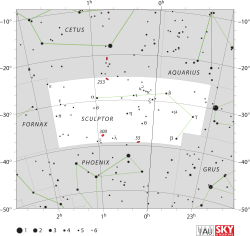Tau Sculptoris
| Tau Sculptoris (τ) | |
 | |
| Observationsdata Epok: J2000.0 | |
|---|---|
| Stjärnbild | Bildhuggaren |
| Rektascension | 01t 36m 08,50799s[1] |
| Deklination | -29° 54′ 26,3540″[1] |
| Skenbar magnitud () | +5,69[2] (6,06 + 7,35) [3] |
| Stjärntyp | |
| Spektraltyp | F2 V[4] |
| B–V | +0,33[2] |
| Astrometri | |
| Radialhastighet () | +3,00 ± 4,50[5] km/s |
| Egenrörelse (µ) | RA: +117,37[1] mas/år Dek.: +46,72[1] mas/år |
| Parallax () | 14,42 ± 0,81[1] |
| Avstånd | 230 ± 10 lå (69 ± 4 pc) |
| Absolut magnitud () | +2,04 + 3,02[6] |
| Detaljer | |
| Massa | 1,56[7] M☉ |
| Radie | 3,15[8] R☉ |
| Luminositet | 4,0[8] L☉ |
| Temperatur | 7 155 ± 243[7] K |
| Metallicitet | -0,12[9] dex |
| Vinkelhastighet | 73,8 ± 7,8[10] km/s |
| Ålder | 1,284[7] miljarder år |
| Andra beteckningar | |
| τ Scl, CD-30° 540, HD 9906, HIP 7463, HR 462, SAO 193201, WDS J01361-2954 [11] | |
Tau Sculptoris (τ Sculptoris, förkortat Tau Scl, τ Scl) som är stjärnans Bayerbeteckning, är en dubbelstjärna[6] belägen i den östra delen av stjärnbilden Bildhuggaren. Den har en kombinerad skenbar magnitud på 5,69[2] och är svagt synlig för blotta ögat där ljusföroreningar ej förekommer. Baserat på parallaxmätning inom Hipparcosuppdraget på ca 14,4[1] mas, beräknas den befinna sig på ett avstånd på ca 230 ljusår (ca 69 parsek) från solen.
Egenskaper[redigera | redigera wikitext]
Primärstjärnan Tau Sculptoris A är en gul till vit stjärna i huvudserien av spektralklass F2 V[4]. Den har en massa som är drygt 50[7] procent större än solens massa, en radie som är ca 3,2[8] gånger större än solens och utsänder från dess fotosfär ca 4,0[8] gånger mera energi än solen vid en effektiv temperatur på ca 7 150[7] K.
Dubbelstjärnan Tau Sculptoris upptäcktes av den engelske astronomen John Herschel 1835. Den aktuella omloppsbilden är baserade på en bråkdel av ett enda omlopp eftersom den uppskattade omloppsperioden är omkring 1 503 år med en excentricitet på 0,6.[6]
Källor[redigera | redigera wikitext]
- Den här artikeln är helt eller delvis baserad på material från engelskspråkiga Wikipedia, tidigare version.
Referenser[redigera | redigera wikitext]
- ^ [a b c d e f] van Leeuwen, F. (2007), "Validation of the new Hipparcos reduction", Astronomy and Astrophysics, 474 (2): 653–664, arXiv:0708.1752 , Bibcode:2007A&A...474..653V, doi:10.1051/0004-6361:20078357.
- ^ [a b c] Johnson, H. L.; et al. (1966), "UBVRIJKL photometry of the bright stars", Communications of the Lunar and Planetary Laboratory, 4 (99), Bibcode:1966CoLPL...4...99J.
- ^ Eggleton, P. P.; Tokovinin, A. A. (September 2008), "A catalogue of multiplicity among bright stellar systems", Monthly Notices of the Royal Astronomical Society, 389 (2): 869–879, arXiv:0806.2878 , Bibcode:2008MNRAS.389..869E, doi:10.1111/j.1365-2966.2008.13596.x.
- ^ [a b] Houk, Nancy (1979), Michigan catalogue of two-dimensional spectral types for the HD stars, 3, Ann Arbor, Michigan: Dept. of Astronomy, University of Michigan, Bibcode:1982MSS...C03....0H.
- ^ de Bruijne, J. H. J.; Eilers, A.-C. (October 2012), "Radial velocities for the HIPPARCOS-Gaia Hundred-Thousand-Proper-Motion project", Astronomy & Astrophysics, 546: 14, arXiv:1208.3048 , Bibcode:2012A&A...546A..61D, doi:10.1051/0004-6361/201219219, A61.
- ^ [a b c] Cvetkovic, Z.; Novakovic, B. (December 2006), "Orbits For Sixteen Binaries", Serbian Astronomical Journal, Bibcode:2006SerAJ.173...73C, doi:10.2298/SAJ0673073C.
- ^ [a b c d e] David, Trevor J.; Hillenbrand, Lynne A. (2015), "The Ages of Early-Type Stars: Strömgren Photometric Methods Calibrated, Validated, Tested, and Applied to Hosts and Prospective Hosts of Directly Imaged Exoplanets", The Astrophysical Journal, 804 (2): 146, arXiv:1501.03154 , Bibcode:2015ApJ...804..146D, doi:10.1088/0004-637X/804/2/146.
- ^ [a b c d] https://www.universeguide.com/star/tausculptoris. Hämtad 2018-01-21.
- ^ Casagrande, L.; et al. (2011), "New constraints on the chemical evolution of the solar neighbourhood and Galactic disc(s). Improved astrophysical parameters for the Geneva-Copenhagen Survey", Astronomy & Astrophysics, 530 (A138): 21, arXiv:1103.4651 , Bibcode:2011A&A...530A.138C, doi:10.1051/0004-6361/201016276.
- ^ Ammler-von Eiff, M.; Reiners, A. (June 2012), "New measurements of rotation and differential rotation in A-F stars: are there two populations of differentially rotating stars?", Astronomy & Astrophysics, 542: 31, arXiv:1204.2459 , Bibcode:2012A&A...542A.116A, doi:10.1051/0004-6361/201118724, A116.
- ^ "tau Scl -- Double or multiple star", SIMBAD Astronomical Database, Centre de Données astronomiques de Strasbourg, hämtad 2017-04-11.
Externa länkar[redigera | redigera wikitext]
| ||||||||||||||||





